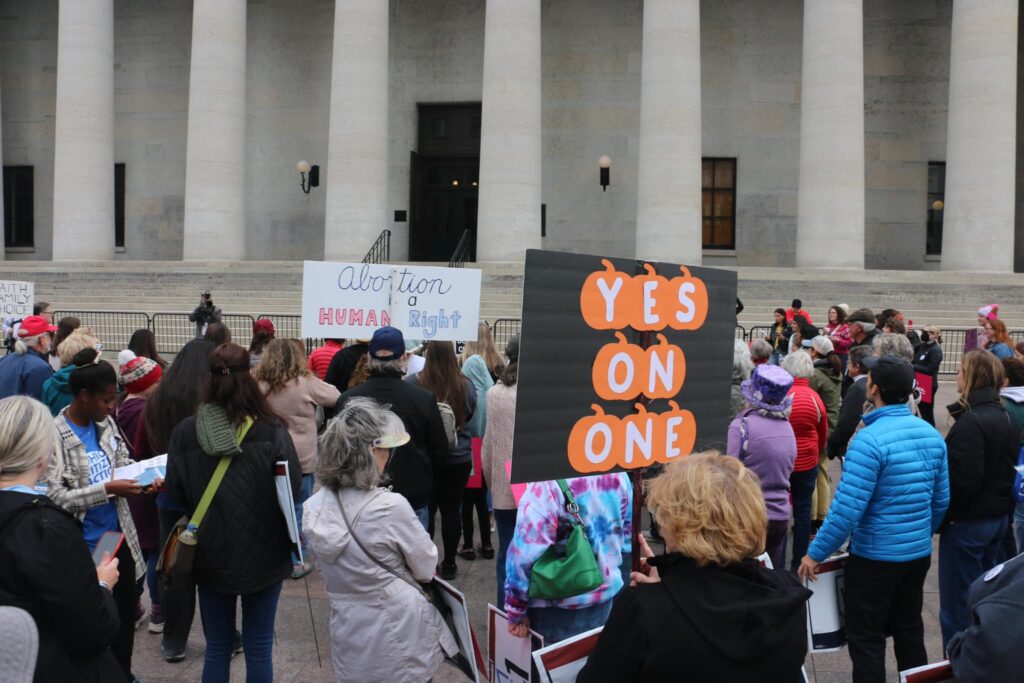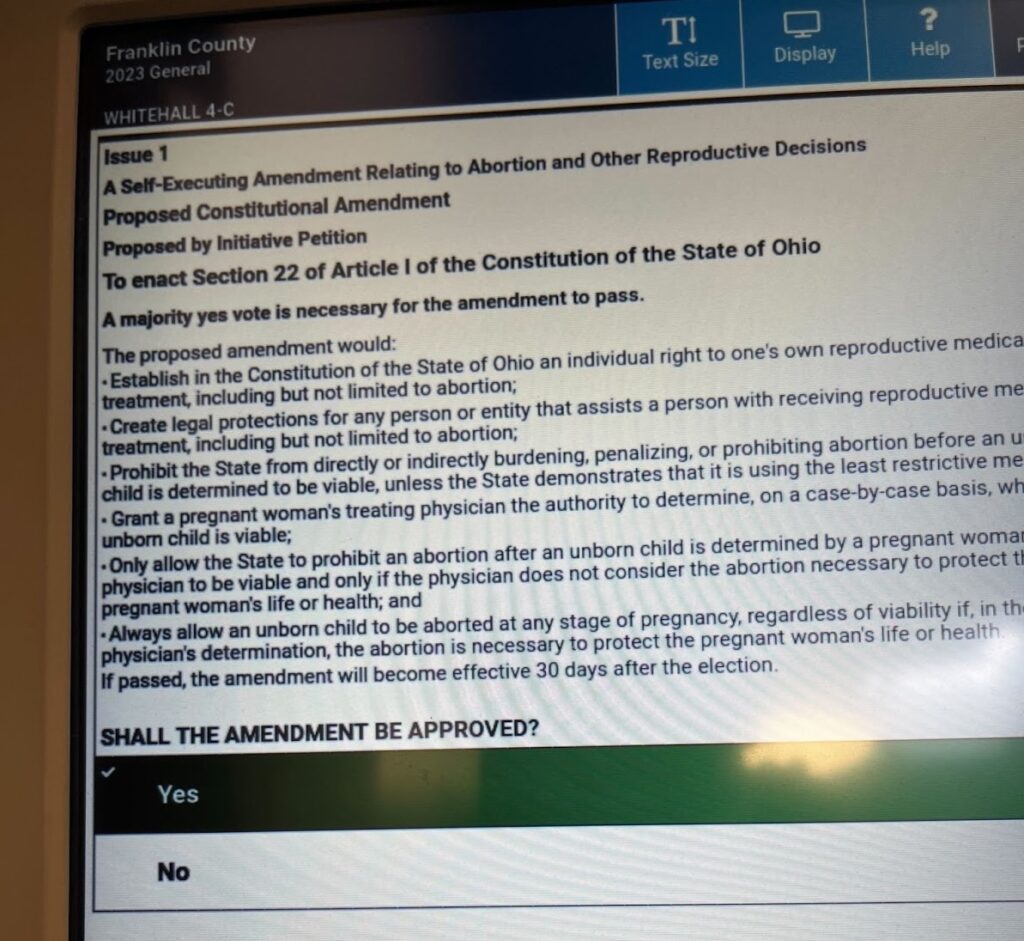To counter Republican and anti-choice talking points about Issue 1, Ohioans United for Reproductive Rights focus on personal medical freedom—and urge voters to vote yes.

In the face of a referendum that could add a right to reproductive freedom to the Ohio constitution, state Republicans have organized a campaign to confuse voters and undermine the democratic process.
After Roe fell last summer and a six-week abortion ban went into effect in the state, Ohio Physicians for Reproductive Rights (OPRR) and other pro-choice advocates turned their focus to a citizen-initiated ballot measure.
As OPRR started collecting signatures to make sure the Reproductive Freedom Amendment would be on the ballot in November, state Republicans started plotting.
They initially tried to make it more difficult to pass referenda. Since 1912, any citizen-led ballot initiative has needed a simple majority, 50 percent-plus 1, of votes to pass. Republican legislators tried to amend the constitution in order to raise that threshold to 60 percent. Republican Ohio Secretary of State Frank LaRose, who spearheaded this threshold-raising amendment, acknowledged it was “100 percent about keeping a radical pro-abortion amendment out of our constitution.”
Thankfully, Ohio voters showed up during an August special election to defeat the amendment—by a 14-point margin.
The defeated threshold-raising amendment was also called Issue 1, and pro-choice advocates had to quickly shift messaging from ‘vote no on Issue 1’ to ‘vote yes on Issue 1’ this November. The confusion does not end there.
Unfazed by the loss, state Republicans embarked on a crusade to push voters away from the Reproductive Freedom Amendment.
First, the Ohio Ballot Board, chaired by Secretary LaRose, decided to present a summary of the amendment on the ballot, rather than the actual amendment. The Ballot Board’s summary used words like “unborn child” instead of “fetus” and originally suggested that the amendment would limit the actions of private citizens, among other changes.
Ohioans United for Reproductive Rights challenged the ballot language in court as misleading; those who are in favor of the Reproductive Freedom Amendment could be puzzled by the anti-choice language (“unborn child”) or the fact that this description says that the amendment covers a right to “one’s own reproductive medical treatment” when the actual amendment covers a broad range of reproductive health care decisions, they argued.
In late September, the Ohio supreme court left most of the Ballot Board’s summary intact. The only change was a clarification that the amendment will only impact state interference with reproductive decision-making.

The difference between the ballot language and the actual amendment language could be meaningful.
- A recent Ohio Northern University poll found that when voters were presented with the actual language of the Reproductive Freedom Amendment, 68 percent would vote ‘yes’—as Jessica Valenti noted in an “Abortion, Every Day” newsletter.
- That number decreased to 52 percent when voters were presented with the language that will appear on the ballot.
- Notably, the vast majority of Democrats expressed that they would vote ‘yes’ regardless of the wording.
- Men—Republican and Independent men in particular—accounted for most of the variation in support; they were much more likely to vote ‘yes’ on the actual language of the Reproductive Freedom Amendment than on the language that they will see on Election Day.
Second, Secretary of State LaRose—who is notably also running for U.S. Senate against incumbent Democrat Sherrod Brown—ordered the purge of almost 27,000 Ohioans from voter rolls in late September. In the past, his office has issued news releases before or after canceling inactive voter registrations, but his office neglected to announce this move. Announcements of voter purges allow voting rights groups to contact those removed from rolls and help them re-register. But LaRose quietly canceled these registrations a mere 12 days before the registration deadline (Oct. 10) for the November election.
LaRose claims that he was merely following the law, but as Democrat State Rep. Bride Rose Sweeney pointed out in a letter to his office, LaRose originally scheduled this voter purge for July of 2023. He conveniently delayed it when Republican legislators scheduled the August special election, and he rescheduled it just in time to prevent around 27,000 Ohioans from voting on Issue 1.
Third, Ohio Republicans have launched an all-out public misinformation campaign. In a series of ads, Protect Women Ohio—the principal anti-choice campaigner in the state this season—falsely advertises that the Reproductive Freedom Amendment would: overturn the state’s parental consent law (requiring a parent or guardian to consent when a minor has an abortion), create a right to gender-affirming surgery for minors and allow abortion up until the moment of birth. Most recently, they claimed that “[r]apists and pedophiles will benefit if Issue 1 passes.”
Hi 👋 We're OURR — the grassroots organization fighting to protect reproductive freedom in Ohio.
— Ohioans United for Reproductive Rights (@OURR2023) October 19, 2023
The election is coming up on 11/7, and we can't win this fight without your support. Will you please chip in $10 to help defeat anti-abortion extremists?https://t.co/Y29fzKU9ke https://t.co/gSs89OlHz4
Dr. Lauren Beene, one of OPRR’s co-founders who routinely confronts the anti-choice myths about Issue 1 as a physician and advocate, said, “It’s all lies. … The amendment will not change any of Ohio’s parental consent laws … and the anti-choice extremists are saying otherwise because they know taht will scare people into voting how they want them to vote.”
The Reproductive Freedom Amendment “has nothing to do with gender-affirming care,” she continued. “They just know it riled people up.”
The anti-choice messaging focuses on protecting children, but she told Ms. that, as a pediatrician, she knows that “without access to reproductive medical care, including abortion, children are going to suffer.”
Nonetheless, in early October, the state’s Republican Attorney General Dave Yost released an “objective analysis” of the Reproductive Freedom Amendment (which he called the “Abortion Amendment”) that echoes the anti-choice ads that have bombarded voters. In his analysis—which he released the same day he spoke at an Ohio Right to Life fundraising dinner—he said the amendment could threaten the state’s parental consent law and potentially limits regulations on gender-affirming care.
When voters were presented with the actual language of the Reproductive Freedom Amendment, 68 percent would vote ‘yes.’ That number decreased to 52 percent when voters were presented with the language that will appear on the ballot.
Yost’s analysis, which was neither procedurally required nor otherwise requested, also claimed that the Reproductive Freedom Amendment “goes further” than Roe—another misleading talking point often highlighted alongside the myth that Issue 1 simply is not necessary.
Republican Governor DeWine repeated Yost’s conclusions with even more certainty in a Protect Women Ohio ad from last month. Joined by his wife, Fran DeWine, the governor said the two “carefully studied” Issue 1 and concluded it “just goes too far” (in addition to repeating the falsehood about the amendment dispensing with parental consent).
A Post-Roe ‘Medical Disaster’
Ohioans United for Reproductive Rights says DeWine knows exactly why Issue 1 is necessary; after all, he signed a six-week abortion ban—with no exceptions for rape or incest—into law in 2019. Since Roe was still law at the time, a federal judge stopped the ban from taking effect: Roe stood for the “well-settled” proposition “that women possess a fundamental [federal] constitutional right of access to abortions,” the judge wrote.
But in July of 2022, Roe was gone, and Attorney General Yost immediately (less than an hour after the Dobbs opinion was released) motioned to revive the ban. The motion was granted. On the same day, Gov. DeWine signed an executive order directing the state department of health to adopt rules associated with his six-week ban, known as the Heartbeat Bill.
The next 82 days were medical hell. Dr. Mae-Lan Wang Winchester, a maternal-fetal medicine specialist in Cleveland, was one of several physicians who instantly saw the ban’s devastating consequences. Winchester explained that “[s]o many people do not know they’re pregnant [before] six weeks…that’s only two weeks after your missed period, and most people aren’t tracking their periods regularly. So almost immediately, that cuts out a large proportion of patients that can no longer get care.”
Such an early ban causes issues for anyone who can, but does not want to, be pregnant; even if someone who would want an abortion could tell that they were pregnant before six weeks, they would also have to find an appointment, endure Ohio’s 24-hour waiting period, and get the abortion—all before six weeks.
More complications arise in the world of maternal-fetal medicine, where Winchester sees many patients who want to be pregnant but are likely to experience complications. At six weeks, little is known: “Before six weeks, we’re not able to diagnose any severe birth defects. … We are not able to predict if a patient will be able to tolerate a pregnancy and remain healthy during that time period. Before six weeks, we’re finding ourselves in pretty murky water—like difficult circumstances where after six weeks, we have a very sick mother, or a fetus with a lethal birth defect.”
That is precisely what happened to Beth and Kyle Long, a couple featured in an ad released by Ohioans United for Reproductive Rights. Beene, who became familiar with their story as the executive director of OPRR, said that Beth Long went through “many rounds of IVF trying to get pregnant.” At 18 weeks, the Longs learned that the fetus’ organs were “on the outside of the body, and there’s no way that that fetus can survive at all.”
Carrying the never-viable fetus was putting a strain on Beth’s body, and she needed an abortion. But, as Kyle says in the ad, “The government here in Ohio took that decision away from us.” They had to leave the state to get Beth the care she needed.
The traumatic interruptions in care also included the story of a 10-year-old girl who was raped and then forced to travel from Ohio to Indiana for abortion care. Her parents sought care for her three days too late: Both three days after the six-week ban started and three days after what would have been six weeks into her pregnancy. The case garnered national attention, with Ohio Republicans—including the state’s Attorney General Yost—claiming that the story was contrived.
A man was charged with raping the 10-year-old girl, who was 9 at the time, in the summer of 2022, and he was sentenced to life in prison a year later. There were at least two other minors who were raped and forced to leave the state to get abortion care because of Ohio’s abortion ban.
The ban is now temporarily halted, but litigation is ongoing. If Issue 1 is successful, the ban cannot go into effect—ever. If Issue 1 fails, the ban could be reinstated depending on the outcome of Preterm-Cleveland v. Yost.
No one should have to leave the state to get the care they need.
— Ohioans United for Reproductive Rights (@OURR2023) October 31, 2023
That’s why Jordyn wants you to #VoteYesOnIssue1. pic.twitter.com/Cpd50Nrcy8
If the ban were revived, doctors across the state would once again be unable to provide abortion care to anyone who has been pregnant for more than six weeks and be terrified to provide care in life-threatening situations. Several affidavits submitted in Preterm-Cleveland v. Yost tell stories of cancer patients who could not continue their chemotherapy treatment because they were pregnant—but they also could not get abortions because of the ban. Other affidavits tell all-too-familiar stories of women who were pushed to the brink of permanent health damage because of “confusion over the meaning of [the ban]’s health exceptions.”
‘It’s Medical Care’
In countering anti-choice talking points—blatant falsehoods about what Issue 1 does—Ohioans United for Reproductive Rights focuses on personal medical freedom.
When Dr. Winchester urges people to vote ‘yes’ on Issue 1, she said she stresses that “it’s medical care. … It’s also about personal decisionmaking, keeping your medical decisions private, not needing permission from the government to do what you and your doctor feel is best for you.” A ‘yes’ on Issue 1 keeps “all these random strangers who should have nothing to do with your medical care—it keeps them out of that decision.”
Election Day is next Tuesday (Nov. 7), and early voting is available on Nov. 4 and 5.
For information on how to vote on Issue 1 in Ohio, head here.
Up next:
U.S. democracy is at a dangerous inflection point—from the demise of abortion rights, to a lack of pay equity and parental leave, to skyrocketing maternal mortality, and attacks on trans health. Left unchecked, these crises will lead to wider gaps in political participation and representation. For 50 years, Ms. has been forging feminist journalism—reporting, rebelling and truth-telling from the front-lines, championing the Equal Rights Amendment, and centering the stories of those most impacted. With all that’s at stake for equality, we are redoubling our commitment for the next 50 years. In turn, we need your help, Support Ms. today with a donation—any amount that is meaningful to you. For as little as $5 each month, you’ll receive the print magazine along with our e-newsletters, action alerts, and invitations to Ms. Studios events and podcasts. We are grateful for your loyalty and ferocity.





